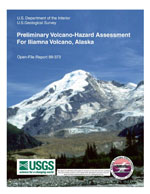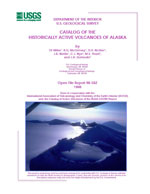Iliamna Red River Lahar
Start: 300 yBP [1]
Event Type: Explosive
Description: From Waythomas and others (2000): "The Red River Valley, including Red Glacier, was a primary flow path for lahars of Holocene age and is an area that is highly susceptible to inundation by future lahars from Iliamna Volcano (Fig. 14 [in original text]). Lahar deposits were discovered at three locations (RR-1, RR-2, and RR-3, Fig. 14 [in original text]) and large stranded blocks of andesite, delivered to this area by lahars, are common on the alluvial fan of Red River and along the beach near exposure RR-3 (Fig. 14 [in original text])."
"Exposure RR-3 is a several-kilometer-long sea bluff located along the Cook Inlet coastline, just north of the mouth of Red River (Fig. 14 [in original text]). A single noncohesive lahar deposit is present at this location (Fig. 17 [in original text]). The lahar deposit is massive, matrix-supported, and contains mostly cobble to boulder-size clasts of andesite and minor amounts of sand-stone. About 15 percent of the clasts in the deposit are angular, 30 percent are subangular, 31 percent are subrounded, and 24 percent are rounded (n=100; Fig. 17 [in original text]). The lahar deposit is normally graded and exhibits intense red-orange oxidation zones (Fig. 17B [in original text]) and oxidation halos around fragile prismatically jointed juvenile andesite clasts. The prismatically jointed clasts indicate that fragments of the erupted magma cooled and contracted after the lahar came to rest (Francis, 1993, p. 252) and in combination with burned wood in the deposit indicate that the lahar was probably still hot when it reached Cook Inlet. The texture of the distal part of the lahar is distinctly finer grained and slightly better sorted (relative to proximal parts of the deposit) indicating that the lahar may have begun transforming to hyperconcentrated flow when the lahar reached the coast (Fig. 17C [in original text])."
"Charred wood fragments, logs, and charcoal from the lahar deposit at RR-3 gave radiocarbon ages of 200+/-300 yr BP and the oldest spruce trees growing on the bluff top are about 280 yr old as determined by tree coring (Beget, 1996 and unpublished data). Thus the lahar and associated eruption must have occurred by at least 300 yr BP. The lahar deposits at RR-1, RR-2, and RR-3 are texturally and compositionally similar and have equivalent stratigraphic positions. These deposits and the large andesite boulders in the Red River alluvial fan are the likely remenants [sic] of an extensive hot lahar initiated by a pyroclastic eruption of Iliamna Volcano about 300 yr BP."
"Exposure RR-3 is a several-kilometer-long sea bluff located along the Cook Inlet coastline, just north of the mouth of Red River (Fig. 14 [in original text]). A single noncohesive lahar deposit is present at this location (Fig. 17 [in original text]). The lahar deposit is massive, matrix-supported, and contains mostly cobble to boulder-size clasts of andesite and minor amounts of sand-stone. About 15 percent of the clasts in the deposit are angular, 30 percent are subangular, 31 percent are subrounded, and 24 percent are rounded (n=100; Fig. 17 [in original text]). The lahar deposit is normally graded and exhibits intense red-orange oxidation zones (Fig. 17B [in original text]) and oxidation halos around fragile prismatically jointed juvenile andesite clasts. The prismatically jointed clasts indicate that fragments of the erupted magma cooled and contracted after the lahar came to rest (Francis, 1993, p. 252) and in combination with burned wood in the deposit indicate that the lahar was probably still hot when it reached Cook Inlet. The texture of the distal part of the lahar is distinctly finer grained and slightly better sorted (relative to proximal parts of the deposit) indicating that the lahar may have begun transforming to hyperconcentrated flow when the lahar reached the coast (Fig. 17C [in original text])."
"Charred wood fragments, logs, and charcoal from the lahar deposit at RR-3 gave radiocarbon ages of 200+/-300 yr BP and the oldest spruce trees growing on the bluff top are about 280 yr old as determined by tree coring (Beget, 1996 and unpublished data). Thus the lahar and associated eruption must have occurred by at least 300 yr BP. The lahar deposits at RR-1, RR-2, and RR-3 are texturally and compositionally similar and have equivalent stratigraphic positions. These deposits and the large andesite boulders in the Red River alluvial fan are the likely remenants [sic] of an extensive hot lahar initiated by a pyroclastic eruption of Iliamna Volcano about 300 yr BP."
References Cited
[1] Record of Late Holocene debris avalanches and lahars at Iliamna Volcano, Alaska, 2000
Waythomas, C. F., Miller, T. P., and Beget, J. E., 2000, Record of Late Holocene debris avalanches and lahars at Iliamna Volcano, Alaska: Journal of Volcanology and Geothermal Research, v. 104, n. 1, p. 97-130.[2] Catalog of the historically active volcanoes of Alaska, 1998
Miller, T. P., McGimsey, R. G., Richter, D. H., Riehle, J. R., Nye, C. J., Yount, M. E., and Dumoulin, J. A., 1998, Catalog of the historically active volcanoes of Alaska: U.S. Geological Survey Open-File Report 98-0582, 104 p.Complete Eruption References
Record of Late Holocene debris avalanches and lahars at Iliamna Volcano, Alaska, 2000
Waythomas, C. F., Miller, T. P., and Beget, J. E., 2000, Record of Late Holocene debris avalanches and lahars at Iliamna Volcano, Alaska: Journal of Volcanology and Geothermal Research, v. 104, n. 1, p. 97-130.

Preliminary volcano-hazard assessment for Iliamna Volcano, Alaska, 1999
Waythomas, C. F., and Miller, T. P., 1999, Preliminary volcano-hazard assessment for Iliamna Volcano, Alaska: U.S. Geological Survey Open-File Report 99-0373, 31 p., 1 sheet, scale unknown.

Catalog of the historically active volcanoes of Alaska, 1998
Miller, T. P., McGimsey, R. G., Richter, D. H., Riehle, J. R., Nye, C. J., Yount, M. E., and Dumoulin, J. A., 1998, Catalog of the historically active volcanoes of Alaska: U.S. Geological Survey Open-File Report 98-0582, 104 p.
